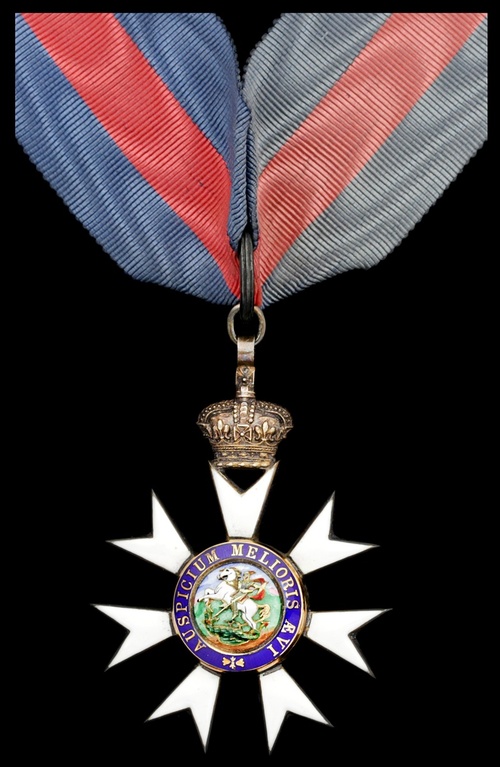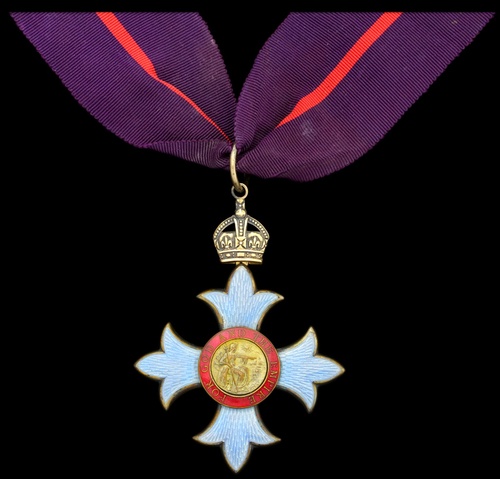Auction: 20001 - Orders, Decorations and Medals - conducted behind closed doors
Lot: 654
An outstanding Great War C.M.G., C.B.E., D.S.O. group of seven awarded to Brevet Lieutenant-Colonel R. E. H. James, Loyal North Lancashire Regiment, late Chinese Regiment - a 'dashing officer' who married one of the most beautiful Chicago heiresses, but was later singled out in his father-in-law's will as not worthy of a penny of his fortune
James became a leading figure in Chicago business circles whilst his son Charles become a wildly successful male fashion designer in the privileged circles of haute couture, the self-styled 'Greatest Couturier in the World'
The Most Distinguished Order of St. Michael and St. George, C.M.G., Companion's neck Badge, silver-gilt and enamel, in its Garrard & Co case of issue; The Most Excellent Order of the British Empire, C.B.E. (Military) Commander's 1st type neck Badge, silver-gilt and enamel, complete with full neck riband; Distinguished Service Order, G.V.R., silver-gilt and enamel, with top riband bar; China 1900, no clasp (Capt. R. H. James 1/Chinese Rgt.); British War and Victory Medals, M.I.D. oak leaves (Lt. Col. R. E. H. James.); Coronation 1902, silver, mounted as worn as applicable, green enamel loss to wreaths of second, very fine (7)
C.M.G. Edinburgh Gazette 4 June 1917.
C.B.E. London Gazette 14 October 1919:
'For valuable services in the Civil Engineer-in-Chief's Department, Admiralty.'
D.S.O. London Gazette 1 January 1918.
Ralph Ernest Haweis James was born on 31 October 1875, the son of Lieutenant-Colonel Walter Haweis James, Permanent Under-Secretary at the War Office, late Royal Engineers, who served during the Great War in the Censor's Department and was author of Modern Strategy and The Campaign of 1815: Chiefly in Flanders. Having grown up at the family home of Bushmead Hall in Bedfordshire, James was appointed to a commission with the Loyal North Lancashire Regiment on 29 May 1895, being promoted Lieutenant on 2 October 1897 and Captain on 24 December 1901. Posted to China, he took part in the suppression of the Boxer Rising and was seconded to the 1st Battalion, Chinese Regiment as one of a small number of British officers with responsibility for training and leading Chinese troops who were based at Wei Hai Wei. Attaining a strength of 1300 officers and men at its peak around the turn of the century, the Regiment did good service at Tientsin and during the march on Peking, and such was the standard of training and efficiency that many of the native troops later formed the nucleus of a new police force upon disbandment in 1906.
Reigning Belle of Chicago
Returning home to take appointment as Instructor at the Royal Military College, Sandhurst he attended the Coronation of Edward VII and had the good fortune to meet Miss Louise Brega, only daughter of Charles W. Brega, one of the wealthiest men in Chicago, as they travelled to England aboard an ocean liner. Considered 'one of Chicago's most glamorous society girls' (The Chicago Daily Tribune, refers), it was said that dozens of titled suiters had sought her hand because of her beauty and popularity, but her heart quickly fell for the 'dashing' English officer, much to her father's chagrin. Rather shrewdly, Captain James did not waste his time and the couple were married a year later at Grace Church, Chicago, in what The Chicago Daily Tribune termed 'The most fashionable wedding of the year':
'Crowded to the doors, the church was banked with flowers. Miss Brega wore one of the handsomest bridal robes seen this year. It was of lace, fashioned with full court train, which fell from the shoulders, the entire foundation of the gown being of silver gauze. The bodice had yoke and sleeves of tulle, and about the corsage the lace was caught with a diamond and pearl brooch, the gift of the groom.'
The bride's father departed his home at 2816 Michigan Avenue shortly after the wedding and retired to Rome on vacation. Returning home to Chicago, he was taken ill at the Chicago Club in 1906 and died alone at St. Luke's Hospital of complications, his wife Fanny being at that time in London. As one might have expected, his dislike of his son in law manifested itself after his death; the will relating to his $400,000 fortune contained a codicil that following the death of his wife, all residue would go to his daughter and 'never shall be subjected to the control of Mrs James' husband, and that no part of it be diverted to pay any debts of his' (Brega Codicil Explained, Chicago Daily Tribune, refers).
It was denied that there had been disagreement between the two men, Captain James being at that time a Professor of Military History at Camberley and appearing to be outwardly successful and of no need of his father in law's money, but whatever the case, the mistrust and disapproval remained after death.
Returning to London, Captain James and his wife set up home at Agincourt House, Camberley, and became parents to Charles Brega James on 18 July 1906. The couple were joined by Fanny Brega and lived at 47 Draycott Place, Chelsea, their son being sent to boarding school at Harrow. Here the young boy was surrounded by luminaries such as Evelyn Waugh, Francis Rose and most notably the photographer Cecil Beaton, who became a longstanding friend. His father meanwhile was promoted Brevet Lieutenant-Colonel on 3 June 1915 and was posted to France with his Regiment on 28 June 1916 following a two year spell as General Staff Officer (First Grade) at GHQ, Home Forces. Four times mentioned in despatches in a single year (London Gazette 30 March 1917, 15 May 1917, 27 July 1917 & 11 December 1917, refer), James was decorated with the D.S.O. for 'personal bravery in France' (The Chicago Daily Tribune, refers), and later received the C.M.G. after working as Director of Organisation in the department of the Civil Engineer-in-Chief at the Admiralty from January 1918-May 1919.
The Genius of Charles James
Expelled from Harrow after three terms around 1920, reputedly as a result of a 'sexual escapade' (The New Yorker, refers), James's son Charles began to make a name for himself in the field of women's fashion - likely influenced by his mother's exquisite taste and ability to afford the pinnacle of haute-couture. In her study Fashion and Eroticism, author Valerie Steele points out that 'rich Edwardian women dressed with the aims of enhancing their natural attributes, concealing their defects, and signally their social status, and those tenets remained central for James'. To an outsider, it soon became clear that father and son were like chalk and cheese:
'At home, James had a troubled relationship with his father; it was clear early on that he was not only gay but flamboyantly so, and entirely uninterested in the military. It was said that Charles used to make fun of the inordinate attention that he father paid to the style and cut of his military vest intimating that he, too, was a homosexual aesthete' (The New Yorker, refers).
To spare his family further perceived embarrassment, Charles returned to his mother's roots in Chicago and soon became an artisan of startling originality, running a successful hat business under the professional alias Charles Boucheron. His parents subsequently returned to live in Chicago and witnessed the business blossom. In 1928, with money borrowed from a family friend, Charles left Chicago for New York and sold his hats at Best & Co., clients including the opera singer Lily Pons, actress Jennifer Jones and the sculptor Elizabeth Strong de Cuevas. In 1937 he debuted his first Paris collection, his couture being sold by Harrods and Bergdorf Goodman in New York. In 1948 Charles held the retrospective exhibition 'Decade of Design' at the Brooklyn Museum in New York, and here he highlighted dresses created for his greatest American patron, Millicent Rogers, the Standard Oil heiress famed for inventing haute couture 'Happy Chic'. His client list was legendary; in the 1940's he counted the ballerina Alicia Markova and Diana Mitford amongst his friends, whilst a certain Mrs. Elizabeth N. Graham - known professionally as Elizabeth Arden - helped establish an American clientele of Whitneys, Hearsts and Paleys which would last a lifetime and fill the covers of Vogue Magazine for decades.
The great Spanish-born couturier Balenciaga, a master of form himself, bestowed on James the following accolade:
'Charles James is not only the most eminent American couturier, but also the best, and the only one who has raised Haute Couture from applied art form to pure art form.'
Praise indeed.
Later life
Witnessing his son's embryonic business flourish on both sides of the pond, James was promoted Lieutenant Colonel on 16 November 1919, but left the British Army soon thereafter. He took work on the staff of the late Samuel Insull - who had made a fortune from creating an integrated electrical infrastructure in the United States - and later became Head of the Chicago District firm, a subsidiary of Commonwealth Edison of Indiana. Father to daughters Frances and Margaret as well as Charles, James retired from the utility in 1952 and died aged 89 on 25 December 1964, having witnessed an extraordinary life. He is buried alongside his wife at Rosehill Cemetery and Mausoleum in Chicago.
Sold with copied MIC and a large file of copied research offering a fascinating insight as to the life of Lieutenant-Colonel James and his hugely successful son, with a hardback copy of Charles James, Assouline, by Richard Martin, former Curator of the Costume Institute of the Metropolitan Museum of Art, New York.
Subject to 20% VAT on Buyer’s Premium. For more information please view Terms and Conditions for Buyers.
Sold for
£2,200
Starting price
£1600









